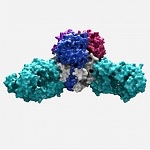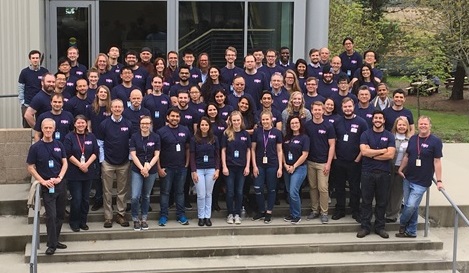Vol. 17, No. 10 - May 2017
View the Archives

From Our DirectorSSRL just completed our DOE Basic Energy Sciences Triennial Review. The review highlighted the high impact of SSRL user science, the quality of SSRL user support, the reliability of SPEAR3 performance, and a strong commitment to science education. I would like to thank the user community, the SSRL User Executive Committee in particular, and the SSRL staff for your essential roles in making SSRL a successful scientific organization. One example shared with the reviewers was the user surveys, which documented an exceptionally high level of user satisfaction. Thank you for your support!
In preparation for the Triennial Review, we have reinvigorated our Strategic Plan, which you can find at the SSRL home page. Our planning includes three new undulator beam lines, and two new bending magnet beam lines, all in construction, and an increasing commitment to in-situ and operando measurements, x-ray emission and Raman measurement throughout the x-ray spectrum, and picosecond science. For details, please see the Strategic Plan. Keeping our plan current and compelling is critical and we ask for your continued contributions to our planning. Kelly Gaffney Science Highlights
Thermodynamic Preservation of Carbon in Anoxic Environments – Contacts: Kristin Boye and John Bargar, SSRL While scientists recognize that oxygen-free soil stores large amounts of carbon, knowledge about the processes that protect and preserve carbon-rich molecules in these environments is lacking. In oxygen-rich soil, microbes break down organic molecules through aerobic respiration, allowing carbon to escape the ground as carbon dioxide gas. Read more... See also, Stanford News article Shunned by microbes, organic carbon can resist breakdown in underground environments More SSRL SciencePerseverance Pays Off in Fight Against Deadly Lassa Virus Excerpt from June 1, 2017 News Release
Before Ebola virus ever struck West Africa, locals were already on the lookout for a deadly pathogen: Lassa virus. With thousands dying from Lassa every year—and the potential for the virus to cause even larger outbreaks—researchers are committed to designing a vaccine to stop it. A team at The Scripps Research Institute (TSRI) led by Staff Scientist Kathryn Hastie and Professor Erica Ollmann Saphire has solved the structure of the viral machinery that Lassa virus uses to enter human cells using diffraction data collected at SSRL BL12-2. Their study, published June 2, 2017 in the journal Science, is the first to show a key piece of the viral structure, called the surface glycoprotein, for any member of the deadly arenavirus family. Importantly, the new structure provides a blueprint to design a Lassa virus vaccine. Read more... Meeting SummaryRapiData 2017
The RapiData 2017 practical workshop in macromolecular x-ray crystallography was hosted by the Structural Molecular Biology (SMB) group at SSRL during April 16-21, 2017. The continuing aim of this course is to educate and train young scientists in data collection and processing methods at synchrotron beam lines, using state-of-the-art software and instrumentation. The co-organizers of the 2017 course were SSRL scientists Ana Gonzalez, Clyde Smith and Silvia Russi. The 2017 course attracted 43 early career scientists, mainly postgraduate students and postdoctoral researchers, but also some master students, research staff and junior faculty from around the world. One important mandate for all the previous RapiData courses has been to encourage attendance by young scientists from Latin America with the assistance of scholarships from the International Union of Crystallography (IUCr). On Sunday April 16, Bob Sweet (Brookhaven National Laboratory) gave a five-hour lecture course on the fundamentals of crystallography to ensure that students without much previous experience in crystallography benefit fully from the lectures and practicals during the rest of the course. On Monday and Tuesday there were lectures covering topics ranging from light sources, beam line instrumentation, sample preparation, data collection, indexing, integration, phasing and complementary techniques. Participants were also able to tour the serial femtocrystallography facilities at the LCLS. Hands-on tutorials on data reduction and structure solving software started on Tuesday evening and ran in parallel over Wednesday and Thursday, with sample preparation and data collection tutorials at five SSRL beam lines. The course ended on Friday morning with the awards to the winners of the IUCr and Stanford Bio-X travel scholarships, followed by a round table feedback meeting. Both students and speakers and tutors expressed a high degree of satisfaction with the course. Upcoming EventscanSAS-IX Meeting, June 5-7, 2017, San Francisco, CA For more information please visit both canSAS and the meeting website SSRL 2017 Summer School on Synchrotron X-ray Absorption Spectroscopy and Imaging, June 19-23, Menlo Park, CA Additional information is available at school web portal 7th International Conferences on Hard X-ray Photoelectron Spectroscopy, September 11-15, 2017, Berkeley, CA Register online or contact the Co-Chairs for more information: Piero Pianetta (Stanford/SSRL), Chuck Fadley (UC Davis/LBNL) and Zahid Hussain (LBNL). Conference website SSRL/LCLS Users' Conference & Workshops, September 27-29, 2017, Menlo Park, CA – Save the Date Planning is underway for the joint SSRL/LCLS Users' Conference, to be held at SLAC, September 27-29, 2017. A plenary session with a poster session, awards and invited speakers is planned for September 28. Parallel workshops will be planned for September 27 and 29, including:
We anticipate that registration will open at the conference website next month. We look forward to your feedback and participation! AnnouncementsNomination Deadlines for Annual Awards
User Research AdministrationTomoko Nakai Joins SSRL User Office Stop by Building 120, Room 211 and introduce yourself to Tomoko Nakai who recently joined the SSRL User Research Administration team. Tomoko will be the primary contact for users submitting proposals and conducting experiments on SSRL's Chemistry, Catalysis and Material Science beam lines as well as the general user administrator supporting users and staff in Buildings 120/130/131. Prior to joining SSRL, Tomoko worked in the Office of Research, University of California Davis, where she held positions as Research Development Coordinator, Communications Analyst, and Research Program Coordinator. Welcome Tomoko! SSRL Beam Time Request Deadline
SSRL Proposal Deadlines
Note: Rapid Access Requests for selected beam lines can be submitted at any time. Submit proposals and beam time requests through the user portal. The Stanford Synchrotron Radiation Lightsource (SSRL) is a third-generation light source producing extremely bright x-rays for basic and applied research. SSRL attracts and supports scientists from around the world who use its state-of-the-art capabilities to make discoveries that benefit society. SSRL, a U.S. DOE Office of Science national user facility, is a Directorate of SLAC National Accelerator Laboratory, operated by Stanford University for the U.S. Department of Energy Office of Science. The SSRL Structural Molecular Biology Program is supported by the DOE Office of Biological and Environmental Research, and by the National Institutes of Health, National Institute of General Medical Sciences. For more information about SSRL science, operations and schedules, visit http://www-ssrl.slac.stanford.edu. To unsubscribe from SSRL Headlines, just send an e-mail to listserv@slac.stanford.edu with "signoff ssrl-headlines" in the body. To subscribe, send an e-mail to listserv@slac.stanford.edu with "subscribe ssrl-headlines" in the body. Questions? Comments? Contact Lisa Dunn
|




